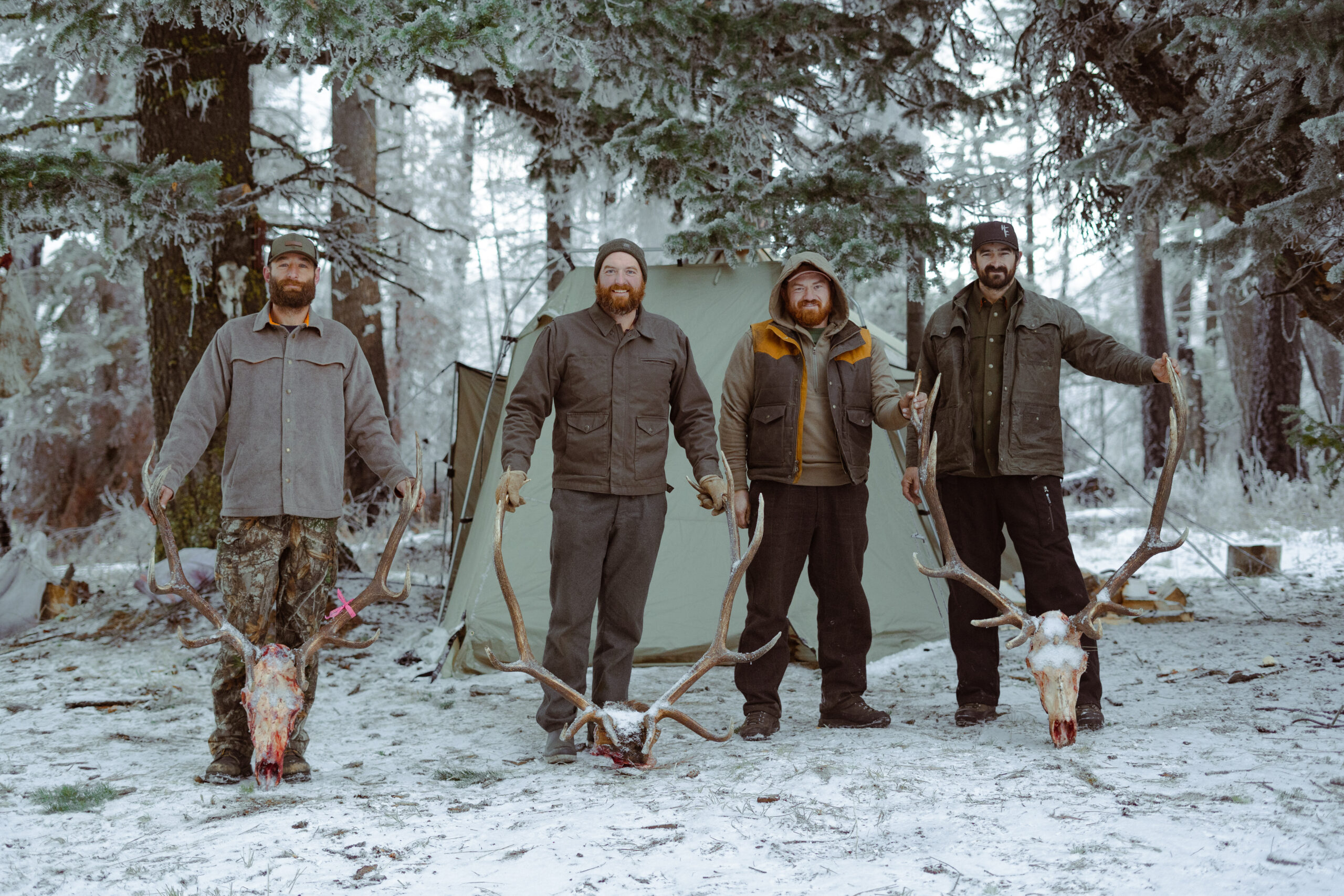Chad, Tyler, Jared, and Kevin have been preparing for an elk hunt in Oregon’s remote backcountry for the last two years. Chad, a father of four, sheep rancher and a world-renowned sheep shearer, would lead the pack train. Tyler is a third-generation Eastern Oregon farmer specializing in seed production and the farm’s lead mechanic. Jared is an avid outdoorsman, wildland firefighter, and builder of irrigation lift pumps for farmers. Kevin, the Vice President of Operations at McFarland Productions took over the role of the trip’s camera operator. He is a seasoned outdoorsman himself with a background in fishing, archery, and guiding elk hunts in Colorado.
Day One
After days of assessing gear and packing two pickups with trailers hauling five horses and three mules, the four hunters finally pointed their trucks northeast, a 12-hour drive to remote Oregon. Two days before the nine-day season opens, they roll in through snow-covered roads, chains clattering against all four tires, the convoy crawling up the mountain one icy mile at a time until they reach the trailhead. Scrambling to set up a temporary base camp in the parking lot, unpacking tents, tarps, cots, and clothes, and feeding the animals, anticipation creeps in. Tomorrow, they would pack everything up to the main camp, 10 to 12 miles deeper into the great outdoors. Before they head off to bed under the starry night, Jared seared a meat and potatoes dinner over an open flame.
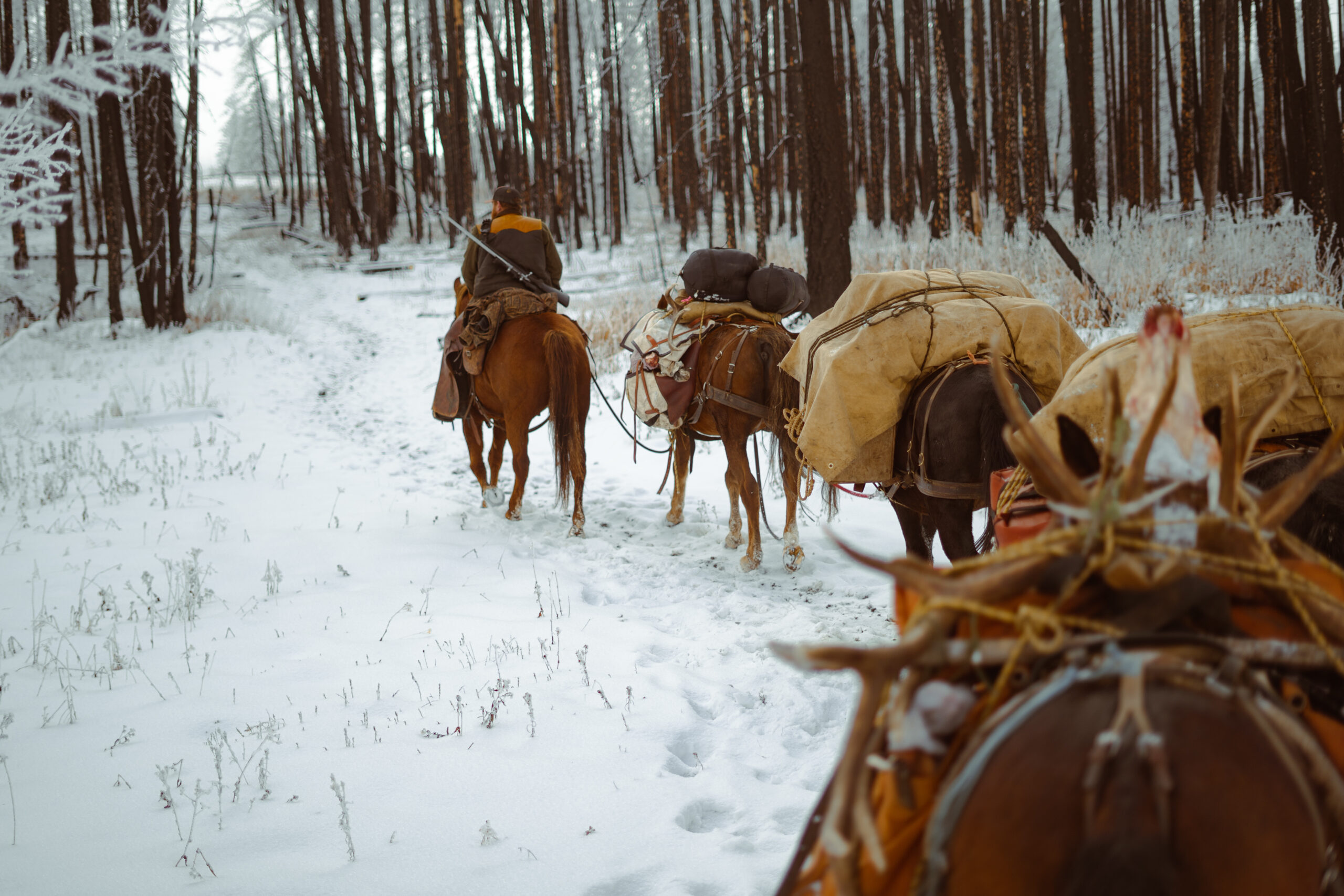
Day Two
Simple but homemade burritos heat up on the stovetop as the group cinches up saddles and stack packs high with coolers, clothes, and feed, the string of horses and mules lined out. Within a few hours, the group starts up the trail, each on horseback, and what belongings fit, leaving a few items deemed unnecessary behind, into packs on the string of mules.
Years back, wildfire scarred these mountains, leaving Chad, the lead rider, to piece the trail together almost from memory, sight unseen. The ride-in was pretty, stopping at water and crossing some small snow drifts. Hooves rang against stone, breath clouded in the cold, but the rhythm of the pack train carried them deeper into the backcountry. Occasionally, the group would dismount to hike through the soil, rock, and grass, giving the horses a rest.
The weather tested their layers, swinging from sun on bare ground to wind cutting sharp across the ridges. Here, gear mattered. Since pack weight and space were slim, the hunters relied on quality pieces and versatility of a variety of Schaefer Outfitter gear. Even with some snow on the ground, it was a warmer winter day and a lightweight jacket shielded the afternoon weather. Keeping prepared as they made their way up the ridge, extra jackets were kept close; tied to the back of their saddles. When the air bit with a chill, they were unfazed, pulling on another layer; the Rangewax High Plains Drifter Jacket, Canvas Ranch Jacket, Rangewax Puffer Vest, or Wool Overshirt kept them warm and dry as they continued their climb.
After five hours of trailing, the group reached what would be their home for the next nine days. The warmer weather through the day melted some of the existing snow, making portions of the last stretch a muddy, icy mess. Unloading packs and setting up a 20×40 tent with a small vestibule to house coolers and grain, then slipping off for a quick scouting trip before dark. With nightfall on the horizon, the weather grows colder by the minute, opting to throw on another layer. The Storm Cotton Hoodie worked as a warm mid-layer to the Heavyweight Cotton Henley underneath and the RangeWax Puffer Vest sitting atop. By the time they returned, night had settled heavy, the stove crackled inside the tent, warming the air and cooking up another camp dinner. Outside, frost was already forming, but inside camp, anticipation burned hotter than the fire.
Day Three
With a day until the season was to open, they prep their bags for hunting and glass the terrain, their binoculars scanning the rolling hills and dense forests. They spotted a few elk here and there, small herds scattered across the landscape. Relying on local knowledge and stories of reliable elk sightings in a particular draw, they spent the morning exploring different areas, finding some signs but not the large herds they hoped for. Then, at midday, a vast clearing stretched out, and on the opposite slope, the glass picked up at least ten bulls spread across three herds. The sight brought silence to the group. They stood grazing along the exposed face of the ridge, shadows cutting long lines behind antlers that swung as they fed. The steepness of the ridge, as seen from their vantage point, suggested spotting them from above would be difficult. Getting to them, however, would be even more of a challenge. It meant dropping down into the canyon, then clawing back up nearly two thousand vertical feet on the opposite side. The trail to the far ridge is an endless series of switchbacks, snaking up and down steep slopes. They would likely have to walk their horse up or down. There’s enough elk in the area they don’t have to leave their hunting radius to drop a bull elk. Circling the kidney bean-shaped clearing nearer camp, checking every draw, they return to camp for lunch, then spot-check the ridge again in the evening, confirming large bulls are still there. Back at camp, they prepare dinner – burgers – and make final preparations for the morning hunt.
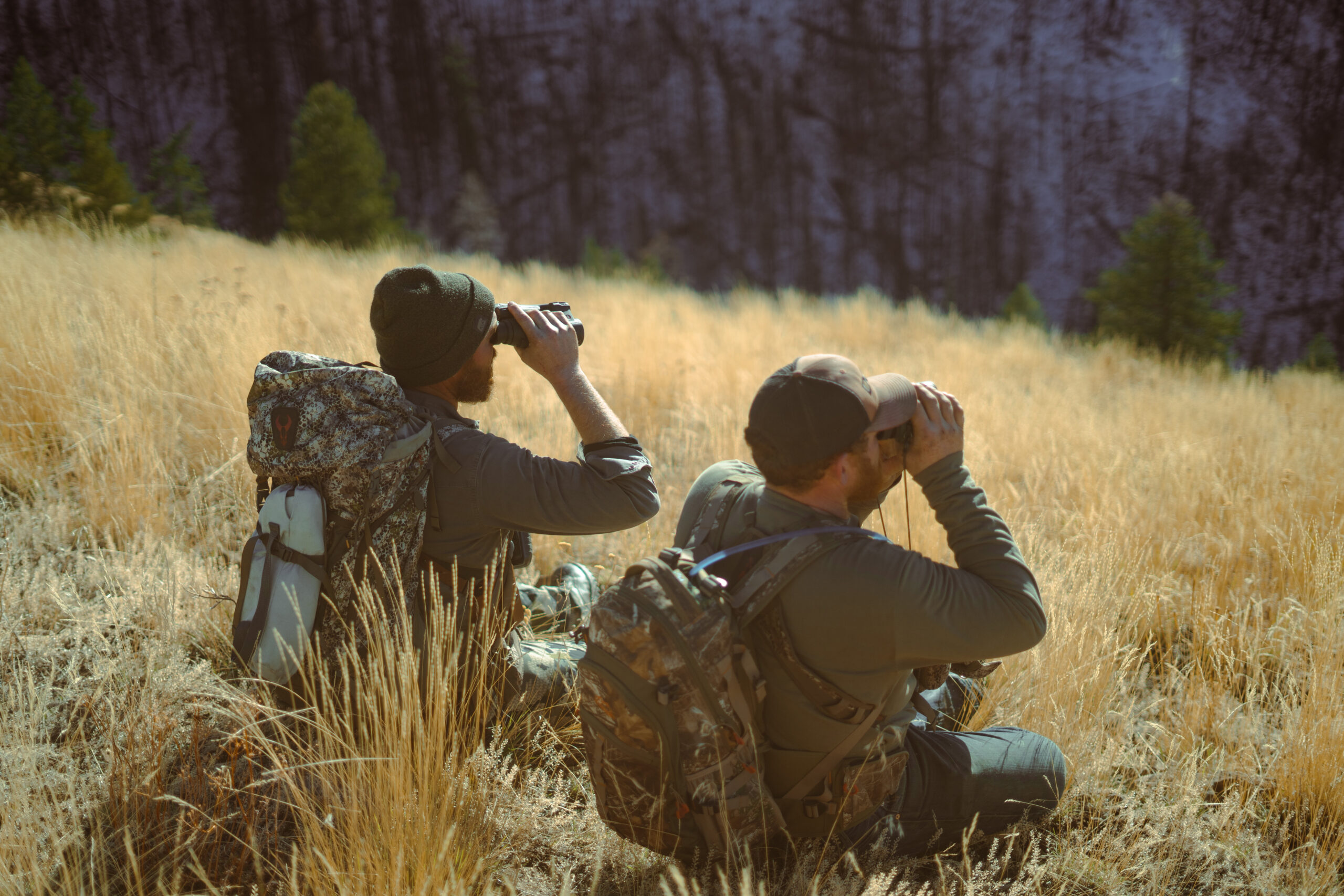
Day 4 – Opening Day of the Season
Opening morning arrives. Before daybreak, Tyler and Kevin head out in one direction, Jared and Chad swung wide for different ground. Tyler and Kevin lock in on the area they previously spotted a few bulls, a location known for consistent elk sightings. However, despite their expectations, they don’t see a single elk all day, except for those on the far canyon ridge. They are relieved they didn’t attempt to hike to that area on opening morning, as they hear 15 to 20 shots. It turns out the area is swarming with hunters. Bundled against the cold in a RangeTek Western Guide Snap Shirt and Western Denim Snap Shirt as their base layers, they pressed on. A light snow begins to fall, accompanied by a thick fog that settles in the lower elevations, severely limiting visibility. They persevere, glassing the areas they can see from their ridge-top, determining if any elk are moving below. Nothing. They continue to work the kidney bean, hoping to locate elk. Nothing. Stopping by camp mid-day to release the horses to graze back at camp, hobbling them to keep them from wandering too far.
Chad and Jared picked their way through a burn scar, the ground still a mess of downed logs and snags that turned every step into a trial. They make a large loop and even getting some close calls, they eventually circle back towards camp, arriving well after dark, just in time for dinner and debriefing on the first day’s hunt.
Day Five
Kevin slipped on his Wool Overshirt, then layered the RangeWax High Plains Drifter Jacket over it, bracing for the cool, wet weather. Snow drifted down in steady flakes as he and Jared headed out to the ridge, scanning the draw from opening day. About 1,000 yards away, tucked into a pocket of trees, a bull elk waited. The terrain looks like a series of ridges with “fingers” extending down. Kevin and Jared start their walk down, through loose shale that shifts with every step.
At roughly 670 yards from the elk, Kevin gets comfortable, dopes his scope, and takes the shot with his custom long-range hunting rifle, a project that began two years prior. Getting to the elk, they cross the creek, climbing to the opposite side, taking at least an hour, to navigate the terrain on foot. Climbing over fallen logs, crossing the creek where they find suitable, they reach the next creek. Slowly going up the creek they find the elk and begin processing it. Jared, remembering the previous year when Kevin helped pack out his elk, generously offered to take a packed load up to the top of the ridge, timing himself and taking roughly an hour, while Kevin finished de-boning.
As Jared returned, a storm rolled their way; they needed to get the next two loads to the top of the hill and fast. Loading their packs heavy for the second, making the remaining trips lighter. While the climb didn’t require ropes, trekking poles, similar to the poles cross-country skiers use, provided extra stability and leverage for the ups and downs. Halfway up the hill, the first of the storm hits. Kevin and Jared repacked their belongings, leaving 2 small meat bags and the antlers at the bottom of the hill, and headed back to camp. About three-quarters of the way to camp, the storm increased, bringing strong wind and snow flurries. Shifting to the leeward side for protection from the storm, they continued side-hilling along the ridge. Successfully making it back to camp, they huddled by the fire, quickly slapping some meat on an open flame while waiting for Tyler and Chad, who had made a ten-hour round trip to the trailhead for supplies.
They returned late, navigating in near-darkness without headlamps to protect their horses’ vision. By that time, it was a blizzard, 30+ mph winds, and they were completely covered in snow. Understandably, they quickly moved in by the fire. Tomorrow would be all about finishing the elk retrieval. Jared, who’d been with Kevin during the kill, planned to hunt solo, while Tyler and Chad opted for a short morning hunt before helping Kevin carry the remainder of his bull to the top of the ridge, and back to camp.
Day Six
The snowstorm from the night before had left its mark, but even beneath the fresh white blanket, wolf tracks traced a path under the trees. The snowfall wasn’t excessive, but the wind was strong. It seemed like the camp had received more snow than where the elk dropped.As they rode toward the retrieval site, the aftermath of an old fire became clear. Trees lay crisscrossed over the trail, turning what little path remained into a maze of downed logs and tangled brush. Chad’s familiarity with the area helped, but even he leaned heavily on the OnX mapping app to avoid losing their way entirely. Since they were already on horseback, preparing to use mules for packing out the elk, they decided to simply pick their way through the dense trees and small, snow-covered meadows.
Tying up their horses and mules, Kevin noticed somethingYellow, oddly bright against the muted winter landscape. He squinted, raising his binoculars, and confirmed what his gut already suspected: a bedded bull elk, its massive form tucked into the slope. The wind roared, driving snowflakes sideways, stinging their faces. From this angle, the shot was impossible, too far, too exposed, and with gusts that could throw even a perfectly lined-up rifle off target.
Happenstantually, Jared suddenly appeared high on the ridge above the elk, against the snowy backdrop. They were able to get the attention of Jared and encouraged him to work the patch of trees below. As Jared climbed down to a small bench above the bull, the rest of the crew watched intensely. Despite being so close, Jared couldn’t see the animal. He cautiously approached the edge of the bench, gun in hand, when suddenly the bull stood up, now perfectly broadside, then immediately dropped back to the ground. Meanwhile, across the canyon, so far away, Chad had time to question if Jared had shot before they heard the sound of the rifle. Having been able to see the whole thing, Kevin, Chad, and Tyler, celebrated Jared’s success, matching Jared’s excitement, what they could see through their binoculars anyways.
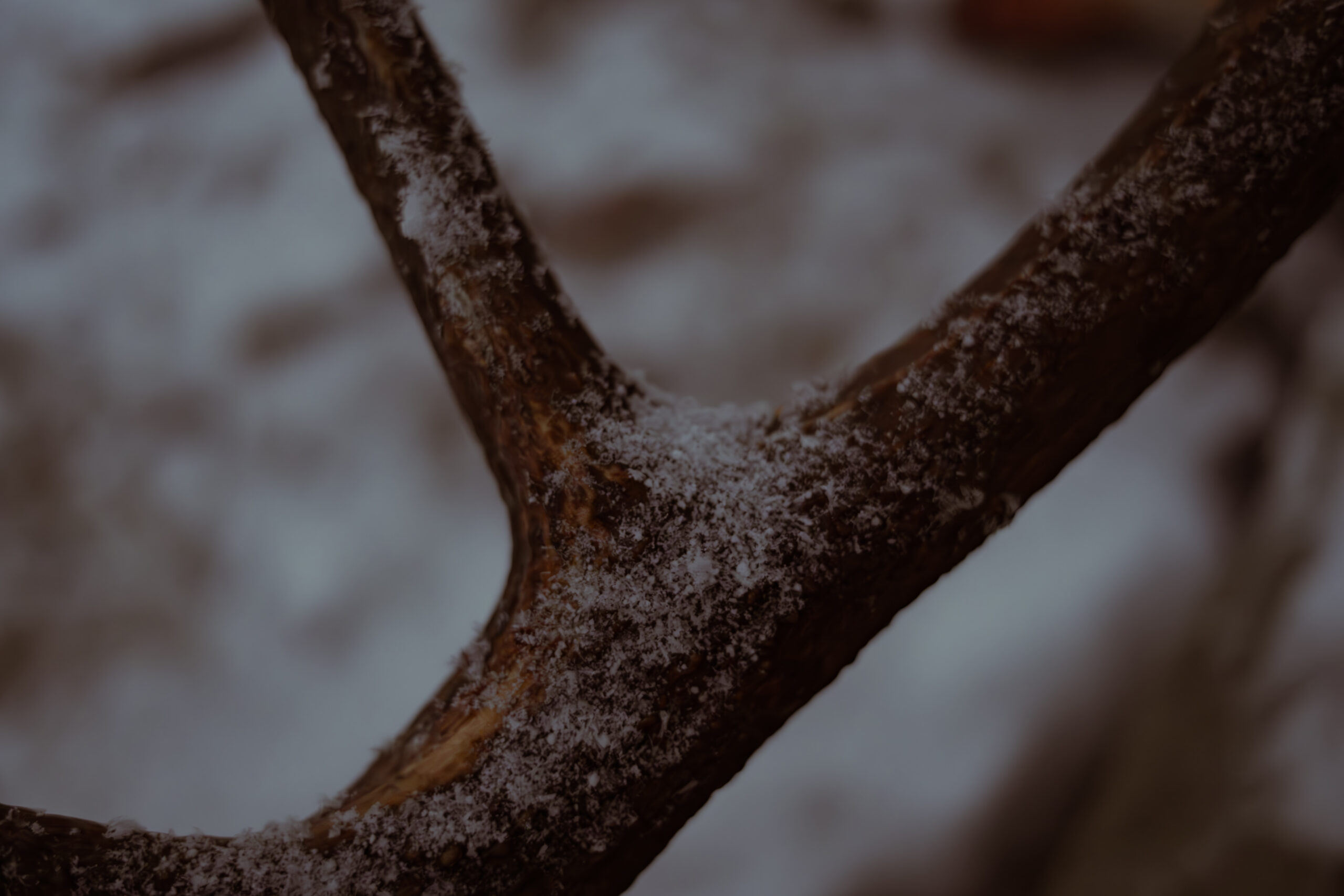
Back to packing out Kevin’s elk, they led one mule down a somewhat treacherous trail, too rough to ride most horses on, to the location where the elk meat was stored on the ridge, and tore down the hill to fetch the remaining 2 bags and antlers. The antlers protruded significantly beyond the mule’s hips and well above its back. If any branches hit the tines, a distinct sound would be made, spooking the pack animals. As daylight would soon fade, Chad was especially careful in choosing a route, making sure not to startle the mules with the sound.
Packing out, they passed numerous old elk tracks in the area, too easy to confuse with their horse tracks, especially with the new snow falling over them. Chad led the pack train, which included the horses and the mule carrying the meat. Kevin made sure nothing slid off the pack train and, crucially, that antlers weren’t hitting any branches. Chad, riding ahead, had a good view of the trail and could anticipate potential problems. They had traveled about 400-500 yards when he suddenly stopped, quickly dismounted, pointing ahead. Kevin looked up to see two bull elk. With dusk falling rapidly, Chad and Tyler were not able to capitalize on the bulls due to decreased visibility.
Mounting back up, darkness deepens, and the weather worsens: snow and fog. The burned landscape looked endless and uniform, making it easy to get disoriented. Relying on their OnX navigation system to guide them back toward their earlier tracks, they knew following the rough path was their best chance of safely returning. Despite the blizzard conditions, they finally made it to the main trail, and then back to camp. Jared had been busy processing his elk and managed to pack one load to the top before returning. Arriving just ahead of the others, he stoked the fire and prepared dinner, ready for their return. Kevin and Jared, both tagged out, would finish packing Jared’s elk in the morning, while Tyler and Chad planned an early hunt for bulls.
Day Seven
With Kevin and Jared tagged out southwest and southeast of camp, Tyler and Chad pushed northeast, farther than anyone had ventured yet. They crossed a large draw, winding through switchbacks, and climbed to the top of a distant ridge. There, Tyler dropped a solid six-by-six bull. Chad spotted another decent bull, leaving Tyler to quarter his elk and prep it for packing. Tyler carried the head and antlers back to camp, arriving late and exhausted, a grin spreading across his snow-dusted face. It was his first bull ever. The next day would be about retrieving the rest of Tyler’s elk, but tonight, the group celebrated.
Day Eight
Following Tyler and Chad’s trail, they navigated challenging terrain to retrieve Tyler’s elk, a three-mile trek into a deep draw lined with switchbacks. The climb up the far side was equally steep. Though rideable, the trail demanded sure-footed animals, and a fallen tree forced them to carefully ride around it.
Fortuitously, a nearby camp had harvested an elk in the same area, and their packer had cleared part of the trail. They briefly scouted where Tyler had shot, hoping Chad might find success, but came up empty. Loading the pack animals, they carefully threaded the steep switchbacks in daylight, noting fresh wolf tracks along the way. The return trip was at night, without headlamps, sidearms at the ready. Uneasy but vigilant, they made it back safely, and that evening brought a rare bit of agreeable weather.
Day Nine
A strong winter storm was predicted to hit the area, causing most hunters to get out of town early. The group collectively decided to stay, keeping warm in their Schaefer Outfitter gear. Their main worry was the potential snowfall, but with only three to five inches forecasted, it didn’t seem like a significant threat, though they monitored the storm in between processing all their harvested elk. After returning from Tyler’s hunt, Chad went out hunting again while Kevin and Jared decided it was time to transport a load of meat back to the trailhead tomorrow. At some point during the night, however, Chad’s horse, the one planned as their packer, somehow slipped its ties, leaving them scrambling to adjust their plans.
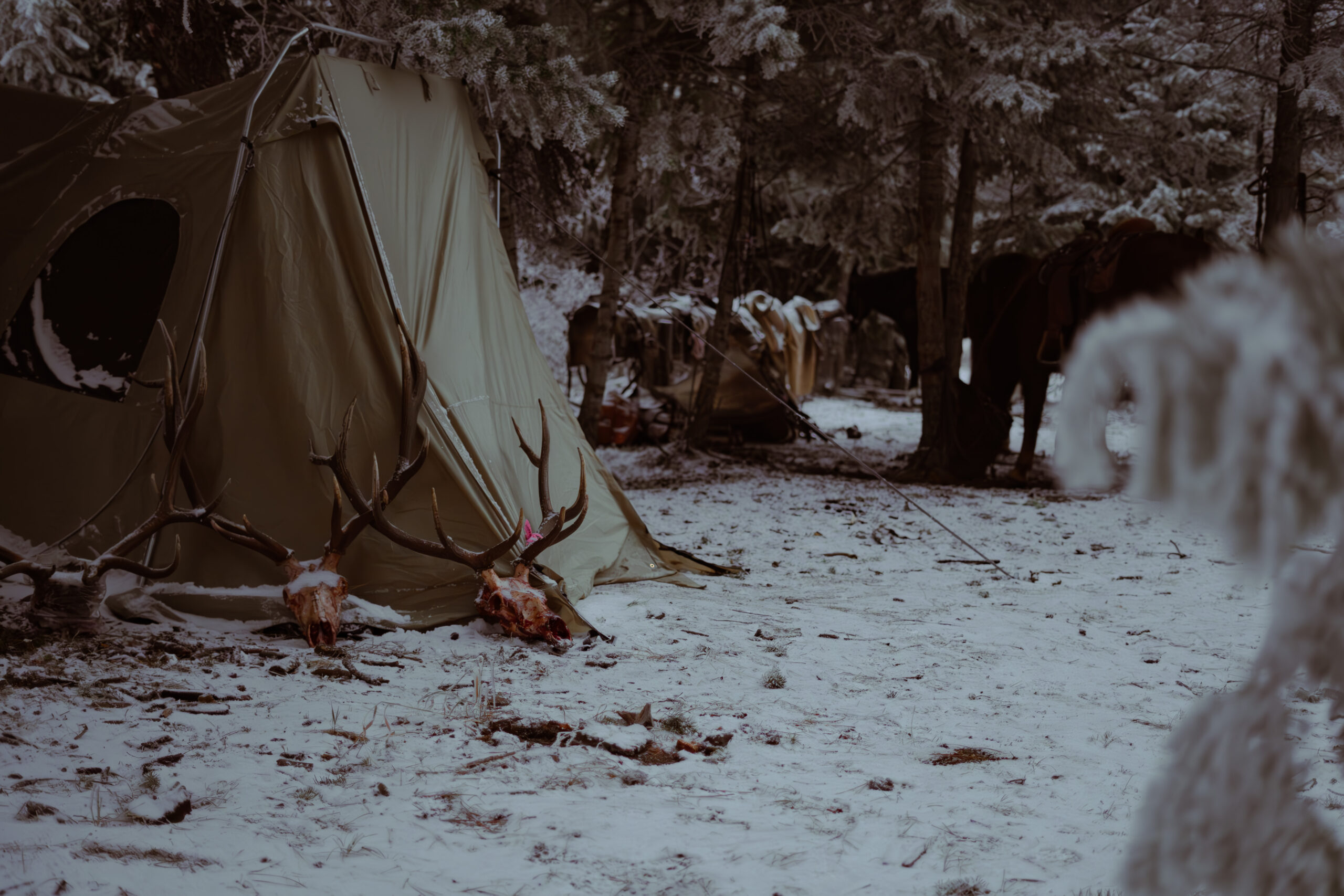
Day Ten
Jared and Kevin woke ready to pack a load of elk meat to the trailhead, but the mules were gone. Smokey, a horse who had never run off before, appeared to be the ringleader. Notably, Smokey, a horse who had never before runoff, was one of the missing, and likely ring leader for their adventure. They followed the snow-dusted tracks, the lead rope dragging behind Smokey making it possible to decipher their path. The herd had already headed back to the trailhead. Kevin and Jared returned to camp, loaded meat on the one mule that stayed, and began the five-hour ride to the trailhead, tracking the rope drag the whole way, running across the occasional wolf tracks.
A horse and two mules arrived at another outfitter’s trailer, and before leaving, they secured the animals in their round pen with food and water. Reaching the trailhead, they gave the animals some alfalfa while they unloaded the meat. Without delay, they headed back up the mountain, riding for about an hour and a half until darkness fell. Unlike their initial trip, where mud had been the primary challenge, this time the cold front had frozen the mud solid, making it incredibly slippery. The horses had to carefully pick their way across the icy, frozen mud. Eventually, making it back to camp for leftover dinner.
Day Eleven
Saturday brought their only chance to leave before the storm trapped them. After breakfast and tending the animals, Chad glassed the draw where Kevin and Jared had success. Seeing nothing, they decided to cut the morning hunt short and prepare to head back to the trucks. Carefully arranging the antlers for packing, they were substantial packs, so they had to allow the horses frequent breaks and even walked several sections themselves. To manage the load, they wore their packs, resting on the shoulders of their Schaefer Outfitter clothing. While riding with packs wasn’t ideal, it was necessary given the time constraints. They wouldn’t have had time for multiple trips, the snowstorm was quickly approaching. As they moved out of the woods, the slippery, frozen conditions persisted; the meadow had accumulated 18-20 inches of snow, catching word the storm had impacted the road conditions. They used TripCheck (Oregon’s road condition website) and Google Maps to determine the best route home, considering the road closures and slowdowns.
Because they only had “cowboy showers” for nearly two weeks, they decided to drive to Tyler’s house, which was out of the way for Chad and Kevin, but showers nonetheless. However, the snowstorm made the drive much longer than anticipated, extending a usual three or four-hour trip to six. The highway was mostly deserted, but the snow on the road, while drivable, was still deep and soft. They drove cautiously until finally arriving around three in the morning.
And so, after years of plans, countless gear checks, and enough anticipation to fill a canyon, the crew wrapped up their trip successfully with 75% tagged out in an area with a roughly 25% success rate.
